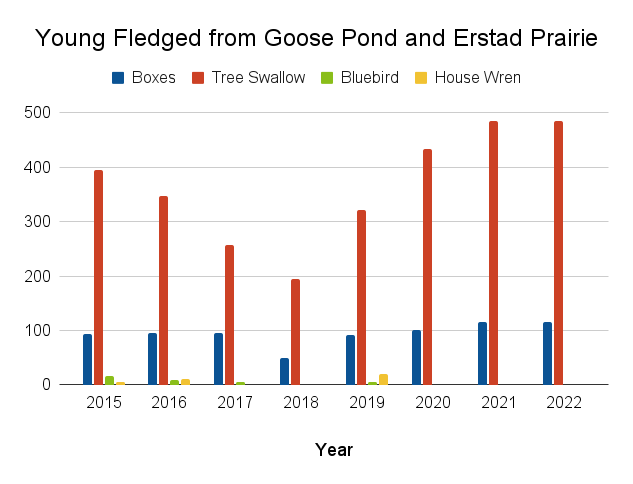After the third or fourth visit to the same house, it starts to feel like you know the neighbors and enjoy their company. Even if those neighbors scold you and swoop about threateningly, it’s no insult—we songbird box monitors know it is the duty of every good Tree Swallow parent to defend their young.
Eastern Bluebirds in a nest box (photo by Graham Steinhauer/Madison Audubon).
In 2022, nine nest box volunteers monitored 116 boxes at Goose Pond and Erstad Prairie, reporting 485 successfully fledged Tree Swallows. Mark Martin and Susan Foote-Martin monitored 43 boxes at their Wildland property where Madison Audubon holds an easement, where 29 bluebirds, 148 Tree Swallows, and 47 House Wrens fledged. Thank you to JD Arnston, Laura Anderson, Bob Bennicoff, Amy and Frank Ihlenfeldt, Mark and Jenny McGinley, Mark Martin and Sue Foote-Martin, Robert O’Connell, Nancy Piraino, and Andrew Wolff.
The nest box design and monitoring protocols we use were originally meant for Eastern Bluebirds. Goose Pond Sanctuary is almost entirely tallgrass prairie, so we rarely have a brood of bluebirds. While we’d love to attract more, they prefer a mix of scattered trees and short grass where they can perch, scan for grasshoppers or cutworms, and land directly on the ground to snatch up a tasty morsel. The few bluebirds we have reported are from Erstad Prairie, where there are scattered oaks and sandy soils that grow short, sparse grass.
Open prairie and large shallow wetlands provide excellent foraging opportunities for Tree Swallows. Like many aerial insectivores (and the insects themselves), their numbers have been declining. Luckily, nest box programs can make a big difference for these iridescent acrobats and other native bird species. According to monitoring data since 2015, nest boxes at Goose Pond and Erstad Prairie have fledged nearly 3,000 birds: 2,921 Tree Swallows, 36 Eastern Bluebirds, and 36 House Wrens.
Graph showing the numbers of bird species fledged from nest boxes by year (illustration by Graham Steinhauer/Madison Audubon).
Besides directly benefitting wildlife, this citizen science project has shown obvious success in increasing public engagement. Enthusiasm is high—I put out a call for volunteer monitors each year in March, and all slots are usually filled within the hour. This year, we’re going to add a 12-box trail at Benade Prairie (70-acre tract acquired by Madison Audubon in 2020) and a 10-box trail at Otsego Marsh.
If you can, I encourage you to install a songbird box on your property. The boxes last a long time, are an excellent educational tool, and the nesting process is captivating for people of all ages. Even one box can make a difference, especially to a pair of swallows, bluebirds, wrens, or other native birds that might have no place to go. While they might get grumpy with you from time to time, at least these neighbors aren’t much for gossip.
Want to make your yard more bird friendly?
Laura Erickson, former Madison Audubon Board member and bird expert, recently published a book called 100 Plants to Feed the Birds: Turn Your Home Garden into a Healthy Bird Habitat. Check it out!
Written by Graham Steinhauer, Goose Pond Sanctuary Land Steward
Cover image: An iridescent navy Tree Swallow perches on top of a nest box (photo by Lesley Haven).







